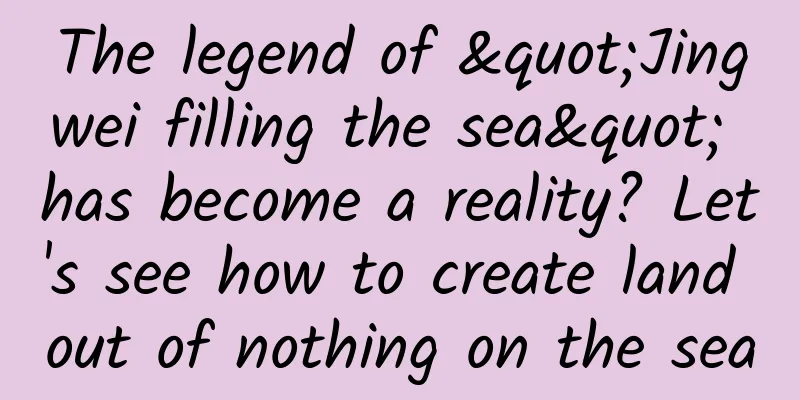The legend of "Jingwei filling the sea" has become a reality? Let's see how to create land out of nothing on the sea

|
In the Netherlands, there is a saying that goes, " God created the world, the Dutch created the Netherlands ." This saying vividly reflects the characteristics of the Netherlands: one-fifth of the land area is reclaimed from the sea. The Netherlands has a land area of 41,500 square kilometers, of which less than 34,000 square kilometers are land (equivalent to the area of Hainan Island), and one-third of the land is below sea level . Faced with the dual challenges of limited land area and flood threats, the Dutch began land reclamation as early as the 13th century, and can be regarded as the ancestors of this field. Image source: Earth Knowledge Bureau 01Where is the land that is quietly growing? In the long history of human interaction with the ocean, land reclamation has become a unique means for cities to expand space and achieve development. After the Netherlands pioneered it, Singapore, Hong Kong, Japan, Dubai and other places also carried out land reclamation projects. Singapore is an island country with a relatively small land area. From the early days of its founding to the present, its land area has increased from the initial 581.5 square kilometers to 728.6 square kilometers, an increase of about 20%. Singapore's land reclamation areas in each 10-year period | Source: Zhou Yun Hong Kong, China , is a mountainous, hilly and coastal area with a small area of available flat land. Since the mid-19th century, Hong Kong has been expanding its land through land reclamation, from the initial splitting of mountains and shores to today's deep-sea development. The reclamation project has increased Hong Kong's land area from the original 1,033 square kilometers to 1,114 square kilometers. Hong Kong's historical reclamation areas and future reclamation plans|Source: Cathay Pacific As an earthquake-prone island country, Japan faces unique challenges in land reclamation. To avoid the risk of offshore landfills sinking due to earthquakes, Japan mainly carries out land reclamation projects in inland seas and bay areas. From 1945 to 1974, more than 1,180 square kilometers of land were newly added through land reclamation. Tokyo Bay's jagged artificial coastline covers almost a whole circumference | Source: The Paper In order to develop tourism, Dubai has created a unique artificial archipelago in the Persian Gulf. Among them, the Palm Jumeirah, known as the eighth wonder of the world, is the world's largest land reclamation project. It took 10 years to build, covers an area of 12 square kilometers, and consumed 5.5 million cubic meters of stone, achieving the miracle of "creating something out of nothing" on the sea. The overall view of Palm Jumeirah|Source: China Architecture 02How to create land out of nothing in the sea? Land reclamation is an activity in which humans use sand, gravel, soil and other materials to transform sea areas into land through engineering and technical means near coastal areas or islands. Depending on the scenario, various methods can be used, such as the "polder method", "caisson method" and " sand blowing to fill islands". “Dirke method” for land reclamation | Source: Bad review The early Dutch cleverly used windmills as a pumping power source, so windmills are everywhere in the Netherlands. These windmills not only have engineering functions, but also have become a unique cultural symbol of the Netherlands. Dutch windmill | Source: Baijiahao "caisson method" The "caisson method" is like "building blocks" on the seabed : first prefabricate reinforced concrete caissons on land, then transport them to the designated sea area and sink them. After the caissons sink to the seabed, multiple caissons will form a supporting base, and then a reinforced concrete layer will be poured on it to form a foundation and covered with soil, thus completing land reclamation. Caisson entering the sea|Source: State-owned Assets Supervision and Administration Commission of the State Council Both the "polder method" and the "caisson method" face a common dilemma: a large amount of fill material needs to be transported from land . This is not only costly, time-consuming and labor-intensive, but also difficult to apply to island projects far from the mainland. To solve this problem, the "blowing sand to fill islands " technology came into being. “Blowing sand” to reclaim land|Source: Sina The "sand blowing and island filling" technology uses dredgers to "blow" sand and seawater from the seabed to the target islands and reefs. This method is easy to obtain materials, can quickly build land , and has low cost and little impact on the environment. In the development of China's Nansha Islands, this technology has played its advantages due to its distance from the mainland and lack of shore-based conditions. By using the sediment on the seabed of the South China Sea, China has successfully achieved "sand blowing and island filling" on eight islands and reefs in the South China Sea, including Meiji Reef, Zhubi Reef, and Yongshu Reef . 03How powerful is the “magic weapon” for land reclamation? The core equipment of the "land reclamation" project is the heavy dredger . The cutter suction dredger and the trailing suction dredger are currently the largest types of dredgers. "Sky Whale" The Tianjing is the first large self-propelled cutter suction dredger built independently in China, with a hull length of 127.5 meters and a maximum dredging depth of 30 meters. When it was built in 2010, its installed power and dredging capacity ranked first in Asia. "Tianjing"|Source: People's Daily Online Equipped with a 4,200-kilowatt auger (the key to dredging capacity), it can excavate 4,500 cubic meters of seabed mixture per hour - enough to fill a half-meter deep pit the size of a standard football field. In 2013, the Tianjing went to the South China Sea and created a miracle of building eight islands and reefs in 200 days, demonstrating China's engineering strength. The "Tianjing" reamer is equipped with 45 reamer teeth Able to dig rocks with a compressive strength of 40 MPa | Source: Guangxi News Channel "Tiankun" In 2019, based on the manufacturing experience of the "Tianjing", China independently developed the "Tiankun" heavy-duty self-propelled cutter suction dredger. The ship is 140 meters long and has a maximum digging depth of 35 meters. It is currently the largest self-propelled cutter suction dredger in Asia. "Tiankun"|Source: Zaojiu During construction, it first inserts two steel piles into a fixed position underwater, and then uses a positioning system and a 6,600-kilowatt super-powerful auger to carry out precise excavation, which can excavate 6,000 cubic meters of soil per hour. The excavated mud and sand are transported to the target filling area through a pipeline system. Cutter suction dredger construction process | Source: Di Fei "New Sturgeon" The "New Sturgeon" is the world's largest and China's first large-scale trailing suction dredger with liquefied natural gas and diesel as a dual-fuel power system. It will be completed in 2023, with a total length of 155.7 meters and a width of 32 meters. It has a 23-ton rake head (the key to dredging capacity), which is like a giant "vacuum cleaner" on the seabed, and can suck the seabed silt into a 17,000 cubic meter mud tank. After the rake head fills the tank with dredging, it is transported to the mud unloading area, and the mud is thrown through the mud door at the bottom or blown to the designated area through the mud discharge pipe system at the head. In just one and a half hours, enough mud and sand can be excavated to raise a football field of more than 7,000 square meters by more than 2 meters. "New Sturgeon"|Source: CCTV News From the ancient legend of "Jingwei filling the sea" to modern hard-core technology, "reclamation of land" has witnessed the progress of human wisdom. This project, which was regarded as "going against the will of heaven" in ancient times, has now become an important field to demonstrate the engineering strength of various countries, providing new possibilities for mankind to open up a broader development space. References [1] Zhou Yun, Chen Tian, Zhang He. Spatial evolution and scale change trend of Singapore's reclamation area[J]. International Urban Planning, 2016, 31(03): 71-77. [2] Luo Zhangren. Analysis of land reclamation and its impact in Hong Kong[J]. Acta Geographica Sinica, 1997, (03): 30-37. [3] Pan Mu. Land reclamation method using caisson[P]. Tianjin: CN201510688583.6, 2017-05-03. [4][Science Popularization China]-"Tiankun": A new tool for land reclamation! - · Science Popularization China Network [5] From "Sky Whale" to "Sky Kun": China's heavy dredging equipment sets sail for a long journey - Central Enterprises - People's Daily Online [6] A Close Look at China's Island-Building Artifact "Tianjing" - Its Self-Propelled Capability is Unique in the World - Military - People's Daily Online [7] CCCC Shanghai Navigation Bureau's dual-fuel powered trailing suction dredger "Xin Haixun" was officially launched_News Pictures_China Government Network Author: Sun Yue, Master Candidate, School of Ocean and Earth Sciences, Tongji University Planner & Editor: Xiaoxiaodandelion Scientific Reviewer: Chen Xinquan, Associate Professor, School of Naval Architecture, Ocean and Civil Engineering, Shanghai Jiao Tong University Cover image source: Shanghai Popular Science, the picture shows the reamer of the "Tiankun" |
<<: I only come here to do three things: elegance, elegance, and elegance!
>>: New research: Get cold! Is it okay to be a little cold?
Recommend
European Automobile Manufacturers Association: Tesla's European sales fell 45% year-on-year to 9,945 units in January 2024
As demand for electric vehicles surges in Europe, ...
Drone mini program functions, how much does it cost to develop a drone mini program?
With the continuous popularity of short videos, ma...
WeChat has been updated again, bringing 3 new features, which may be the smallest upgrade in recent years
After some experience, I found that the new versi...
How did the Cephalosporin family become successful? It can be said that "every generation has its own talents"
The origin of cephalosporins: "friendly forc...
Ice and fire, Kilimanjaro on the equator is a snowy mountain and also a volcano!
Review expert: Researcher Xu Jiandong, Director o...
6 elements, how to trick consumers into placing orders step by step?
Our consumption behavior is 100% controlled. Why ...
2021 Computer Postgraduate Entrance Examination Full Set of Materials (Data Structure, Computer Organization, Operating System, Network Full Course Class)
2021 Computer Postgraduate Entrance Examination F...
How much does it cost to develop a vegetable delivery mini program? How much does it cost to develop a store mini program?
Food is the primary need of the people. Food is v...
These smuggled scales are all we know about the new pangolin species
Recently, scientists discovered a new species of ...
Is the franchise fee of Mudanjiang Steel Mini Program high? Mudanjiang Steel Mini Program Franchise Fees and Process
How much does it cost to join the Mudanjiang Stee...
Just choose 16GB. You can’t add memory to the 21.5-inch 4K iMac.
Apple quietly updated its iMac series yesterday, ...
Apple iOS 15/iPadOS 15 developer preview/public beta Beta 7 released
On August 26, Apple pushed the iOS 15/iPadOS 15 d...
Crack! How many volts are there in the static electricity that makes your fingers spark?
In our daily lives, we often deal with static ele...
The essence of optimizing information flow advertising in 4 industries including home furnishing, decoration, and tourism!
Today, the editor continues to bring you the esse...
Break the circle on Bilibili! 5 key strategies for brand rejuvenation
Starting from animation and then blossoming into ...









